Exploring Canada in winter can be an exceptionally rewarding experience. The scenery is (extra) beautiful, popular tourist destinations are quieter and there are so many fun outdoor activities!
But to make the most of it, you must be wearing the right clothing. Being warm and comfortable is the key difference between just surviving winter and actually enjoying it!
This guide will tell you everything you need to know about what to wear in Canada in winter, from the perspective of someone who moved here 10+ years ago.
This post includes some affiliate links. If you make a qualifying purchase through one of these links, I may receive a small percentage of the sale at no extra cost to you.
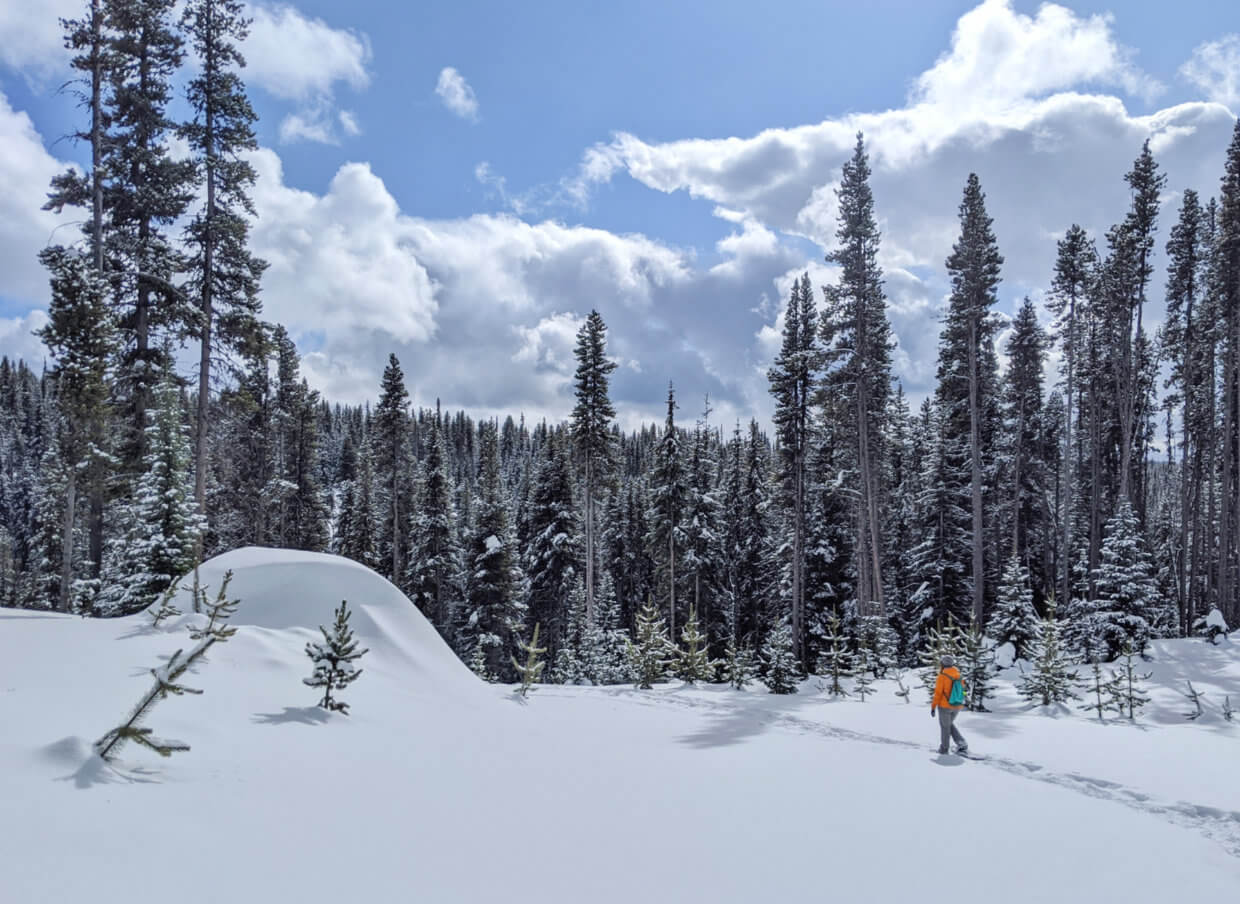
Winter experience
Wondering what I would know about what to wear in Canada in winter? I may be a fairly new Canadian, but I’ve survived winters in New Brunswick (where the ocean actually freezes over) AND in the ‘almost’ sub-arctic city of Fort St John, British Columbia.
The temperature hit below -25c regularly in both locations, with -40c (yes, really!) not being uncommon in Fort St John.
I’ve also driven across Canada in early December, sleeping in a van at -35c. And just for some variation, I’ve spent almost a decade of winters in the warmer areas of British Columbia – on Vancouver Island and in the Okanagan Valley.
As you may guess, I like being outdoors, so in the winter I snowshoe, snowboard and cross-country ski. While I’m not particularly good at the latter its all part of the fun!
I also once managed an outdoor store selling winter gear, so I’m used to giving advice on equipment and clothing.

Essential tips
Here are some key concepts to get your head around when considering what to wear in Canada in winter.
- Layers, layers, layers. Trapped air between clothing layers act as an insulator, keeping you warmer. Wearing multiple layers also makes it possible to adapt to changing temperatures and weather conditions (this includes going indoors)
- Stay dry. Wet clothes are cold clothes so it’s important to keep dry, both from rain/snow and perspiration (sweat). Fabrics play a crucial role in this but you also have to be mindful about avoiding overheating
- Avoid cotton. When cotton gets wet, it says wet (see above)
- Keep your core (torso) warm. When your core is cold, the natural reaction of the human body is to reduce the amount of blood sent to extremities like fingers and toes. Get your core warm first as a priority
- Cover up. Exposed skin is vulnerable to frostbite at very cold temperatures (it can develop within minutes!) Cover as much exposed skin as possible, using clothing and accessories
- Block the wind. Never underestimate the power of wind chill! Wind can really cut through clothing and make the temperatures feel a lot colder. Wear a wind-resistant outer layer to block the wind
- Don’t forget the sun. It’s possible to get sunburned in winter too. Use sunscreen on exposed skin before going outdoors, wear lip balm with SPF and put on a pair of polarized sunglasses. The latter help to reduce the glare from snow
- Cold is subjective. Everyone feels the cold differently. If you’re from a warm country, you’ll likely find Canadian winters a lot colder than the locals do. That’s OK, just remember to layer up more!
- Invest, if you can. Outdoor clothing is one of those things where you get what you pay for. Luckily, thrift stores are full of high quality brands if you aren’t able to buy brand new
Cold weather safety doesn’t stop with clothing – read more about being safe in winter
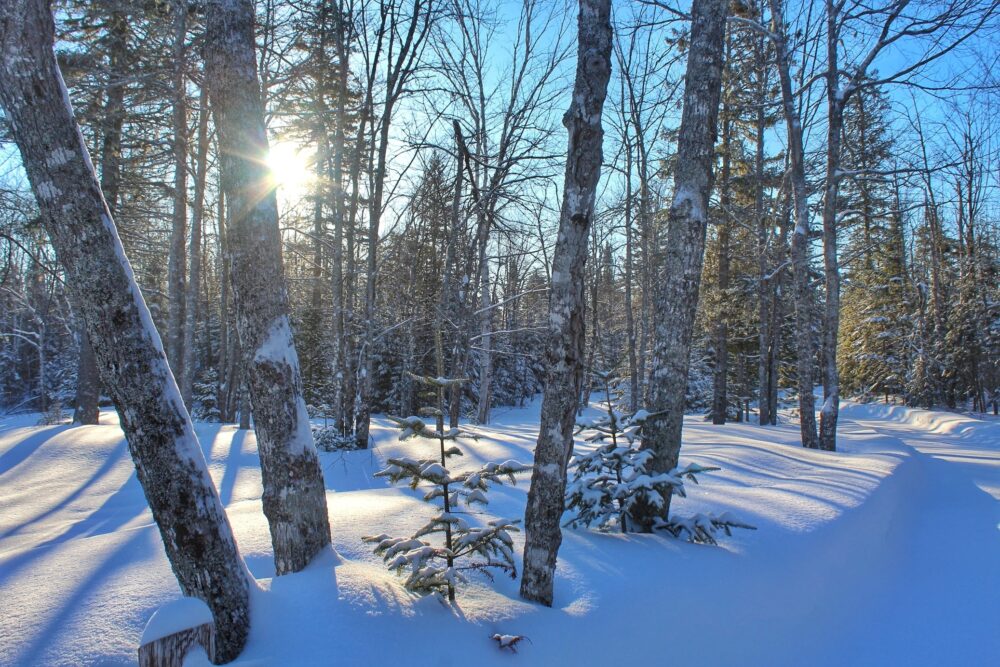
Winter weather across Canada
Canada has some surprising regional variation when it comes to winter weather. Believe it or not, there are places that hardly ever receive snow!
British Columbia: The Pacific coastline of British Columbia experiences the mildest winters anywhere in Canada, averaging 5-8c with torrential amounts of rain. The rest of BC is a mixed bag, with icy-cold conditions in the North, Cariboo and Kootenays. The Okanagan Valley, on the other hand, usually only has snow from December to February.
The North: Winter days in Nunavut, Yukon, Northwest Territories are short and cold. Snow is common but in smaller amounts than you may expect for such northern reaches. Blue skies and sunshine should also be anticipated.
The Prairies: Winter temperatures in Alberta, Saskatchewan and Manitoba are blisteringly cold, especially with wind chill factored in. Rocky Mountain winters are long; the famous aquamarine lakes (Moraine, Peyto etc) are usually frozen until late May/June.
Central Canada: Some areas of Ontario and Quebec have fierce winters, with plenty of snow and freezing weather. The southern areas usually experience milder (but still cold) weather, with a variable amount of snow. The daily ‘high’ in Toronto, Canada’s biggest city, hovers around 0c in January and February.
Atlantic Canada: The provinces of Atlantic Canada (New Brunswick, Nova Scotia, PEI and Newfoundland) are regularly hit by winter storms from the Atlantic, bringing heavy snowfall and plenty of minus temperatures.
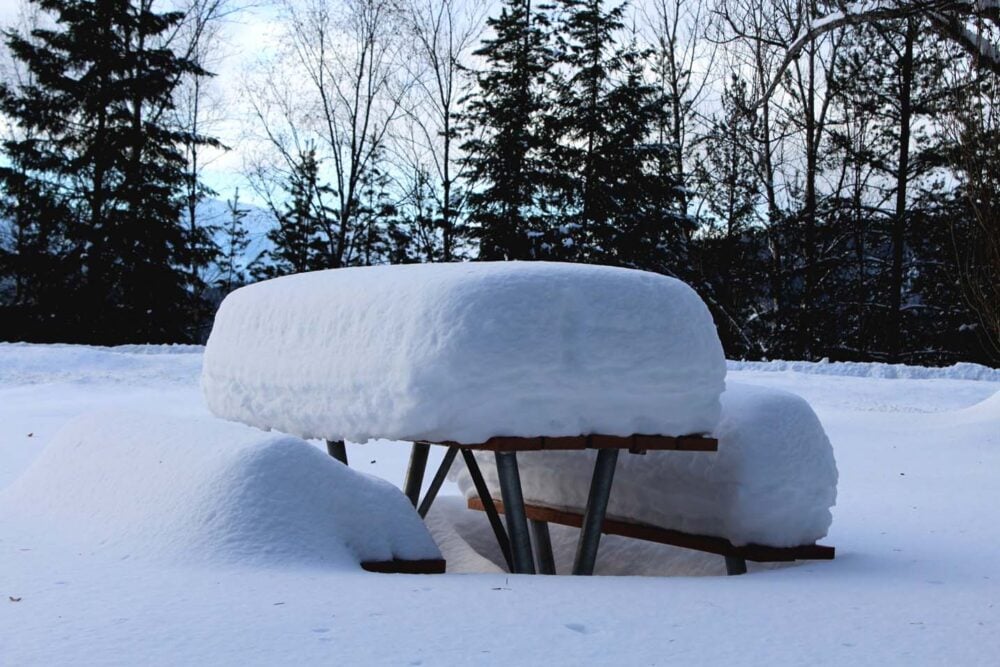
What to wear in Canada in winter
Finally, the nitty gritty you’ve been waiting for. Keep reading to discover all my recommendations concerning what to wear in Canada in winter!
Start with a base layer
Base layers, also known as thermals, are worn next-to-skin. They are designed to move sweat away, a process is called ‘wicking.’ As mentioned above, keeping your skin dry is crucial to remaining warm in winter.
Top base layers feature long sleeves and are usually form fitting (but not skintight). Bottom base layers are similarly slim in style, full length and are often referred to as ‘long underwear’ (or ‘long johns’ for short). Some companies also sell ‘onesie’ base layers.
Base layers are usually sold as with the following options – lightweight, midweight and heavyweight. As a general rule, thicker materials will keep you warmer.
Fabric options for base layers include synthetic materials (nylon, polyester etc), wool or silk. Here’s an example of a synthetic baselayer.
Personally, I prefer merino wool baselayers. While it’s on the pricier side, the biggest advantages are:
- Softer than regular wool (itch-less too!)
- Has an excellent warm to weight ratio (lightweight but super warm)
- Provides warmth even when wet (more than polyester)
- Doesn’t stink as much as its synthetic versions (less washing, hooray!)
- Natural material (available from sustainable, ethical sources too)
Here’s an example of a merino baselayer.
The best base layers
All of my base layers are Icebreaker brand, made from merino wool. Ethically sourced from free range New Zealand sheep, the quality is high. They have lasted me years (and years).
Icebreaker’s base layers fit on the slim side, with an athletic fit. I often double up on them underneath my mid-layer for extra warmth, but without the extra bulk.
Icebreaker uses a numbering system to indicate weight – I personally use 200 for everyday wear and 240/260 for long outdoor days.
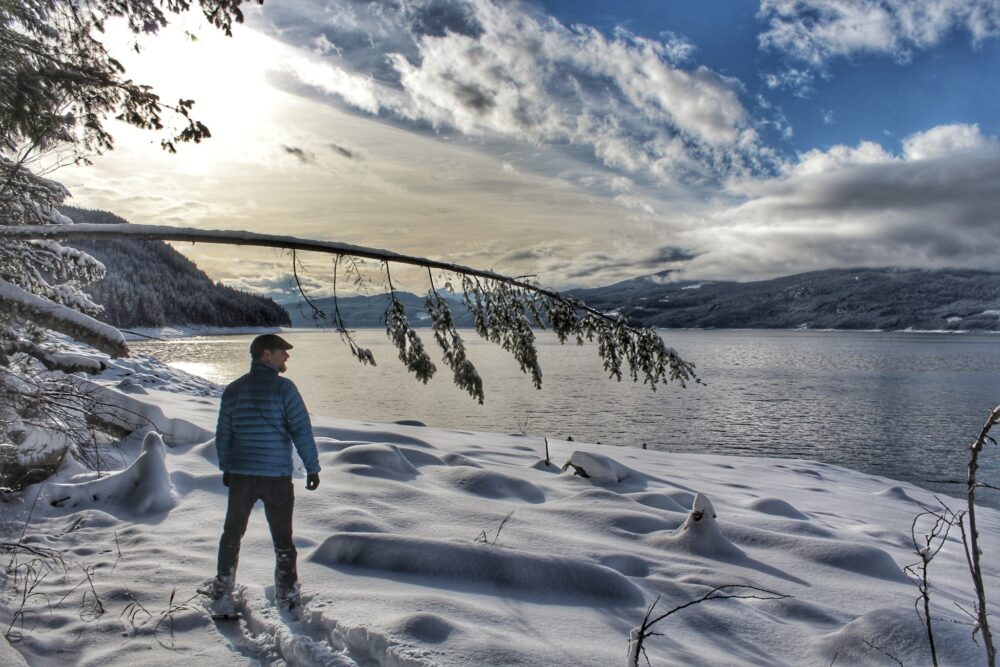
Add a mid-layer
The middle layer is all about insulation. The better this layer traps the heat radiating around your body, the warmer you’ll be!
Top mid-layer
As with base layers, there is lots of choice. A fleece or hoody is a great option, preferably made from polyester or wool if you’re planning to be outside.
Both materials breathe well, to help stop overheating when active. Better breathability does mean less wind resistance, however.
For days around the city, you may choose to wear a cosy sweater for a mid layer instead. Turtleneck sweaters are perfect for keeping the cold out.
Bottom mid-layer
When considering your bottom half, first consider what you’ll be doing.
For active outdoor activities like skiing, snowshoeing and cross country skiing, the combination of a base layer and outer pant (softshell or hardshell, see below) may well be warm enough for you.
If you run colder or are standing/sitting still a lot, you may like to buy a fleece mid-layer (like these) to put between the two.
Alternatively, there’s the option of buying insulated pants (like these). These have an extra built-in layer of warmth underneath the outer layer. This is a very cost effective choice.
If you’re in an urban setting with limited outdoor exposure, you can just use your regular pants over base layer(s). A snow pant can be added on top on particularly snowy or stormy days.
Finish with an outer layer
This is the last layer of protection against the elements.
Warm jacket
In dry conditions, a ‘puffy’ jacket is ideal as an outer layer. These are typically insulated with synthetic, down (feathers), wool or a blend.
Down is generally considered to be the warmest jacket insulator. It does, however, lose its insulation power when moist or wet. Not all down jackets are made equal either. Some factors to consider include:
- Fill power indicates the loft of a down product, which is basically the quality of the down. The higher the number (from 450 to 900 or so), the more insulating air pockets and the warmer it will generally be
- Feather types vary between goose, duck or a combination of the two. Goose is considered warmer and duck less expensive
- Ethical down is traceable back to its source to make sure inhumane farming techniques are not used to procure the feathers. Do your research and look for the RDS certification
Synthetic insulated jackets have a lower price tag than down jackets but perform better when damp/wet and also dry faster. The Patagonia Nano Puff is one of the most popular synthetic down-like jackets.
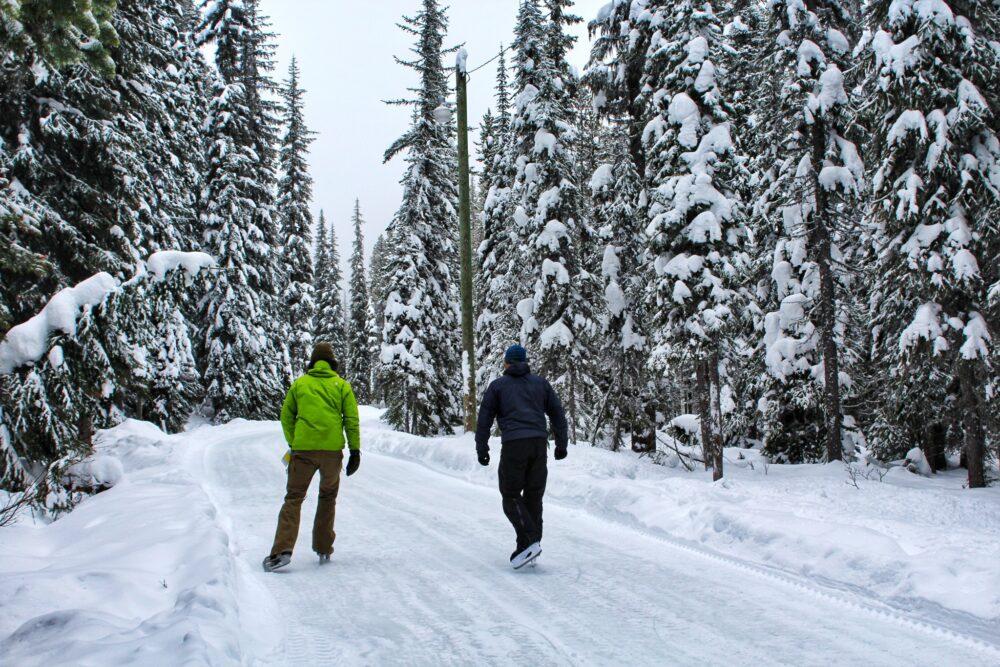
Waterproof shell
In colder, windier and snowier conditions, you will want to use the ‘puffy’ jacket (down or otherwise) as an additional mid layer instead, with a fully waterproof shell jacket on top for wind/rain/snow protection.
I use my synthetic Arc’teryx Atom LT as an outer layer in spring and autumn and then a mid layer underneath a waterproof shell in winter. On colder days, I swap it out with my own Cerium LT jacket.
It is also possible to buy integrated mid layer/shell jackets. This is a good money saving option, but the quality is usually lower than two separate pieces.
Planning on primarily visiting Vancouver and BC’s coast in winter? A waterproof shell is your absolute biggest necessity. You’ll also get a lot of use out of a lighter synthetic jacket (such as the Atom or Nano Puff), to use as an outer layer when the weather is dry. You can then switch it to a mid-layer when the rain comes in.
Pants
Windproof, waterproof snow pants are a must for anyone doing serious snow activities (skiing, ice fishing, snowmobiling) or spending prolonged periods outside.
Also referred to as ‘hardshell pants,’ the primary purpose is to protect you against wind and moisture. Here’s an example of what they look like.
Softshell pants (like these ones) are wind resistant as well as being more breathable and comfortable to wear. I like to use them on warmer snowshoeing days. The catch is that they’re not usually as waterproof as hard shell pants, so don’t try sitting in the snow for long periods of time!

Winter footwear
High cut Sorel winter boots (like these, or these) are perfect for walking around the city and general outdoor activities (shoveling the driveway, snow tubing, snowman building….)
The boot’s bottom part is thick rubber offering waterproof protection against slush. Baffin is another reliable winter boot brand which is very popular in Canada.
I prefer to use my waterproof hiking boots for snowshoeing and winter hiking. Combined with a pair of gaiters, my feet usually remain dry.
Winter boots are fine for casual snowshoeing too, of course, but I enjoy the lighter weight and flexibility of my hiking boots.
For socks, I swear by merino wool! My favourite kind are made by Smartwool – soft, anatomically fitted and durable.
Hat, gloves, neck gaiter
Heat is lost from any body part not covered, which makes wearing a hat an easy way to stay warmer. Toques (beanie hats) are the best option, preferably made of wool.
A neck gaiter is effectively a stretchy neck warmer. The most popular brand is Buff. I love the thicker, fleece ones for winter.
Mittens (yep, the type you probably wore as a kid!) are the warmest type of glove. Fingers lose less heat when not separated so it really can make a difference. The warmest kind of mitten, as you may expect, are those that are insulated with down.
When dexterity is needed, regular gloves (with separated fingers) is the way to go. Ski gloves are built to be worn in the most extreme of conditions, for hours at a time.
When walking around town on mild winter days, I like to use light merino wool gloves like these. They can be used as glove liners too, to provide a softer feel inside a bigger glove.

Useful extras
Handwarmers (single use air-activated heat packs) are handy for times when you need to warm up fast. There are also battery powered versions if you want to avoid one-use products.
For people who run particularly cold, heated gloves and socks can be a life saver! These typically use a rechargeable lithium battery system.
Gaiters are ideal for use when snowshoeing, to prevent powdery snow falling into the top of your boots.
Walking on icy city streets can get slippery, so grab yourself a pair of walking cleats like these Yaktrax Spikes. They right fit on the bottom of your winter boots.
For winter hiking, microspikes are a godsend. These offer more traction than the urban version and are also more durable. I swear by Kahtoola microspikes – super grippy (and we’ve really tested them!) and also very durable. They still look as good as when I bought them.
What to do in Canada in winter
Planning a winter trip to Canada? Now you know what to wear in Canada in winter, the hard part is over! You may find these other posts helpful to resarch your trip:
8 Must See Places On A Winter Road Trip Across Canada
A Complete Guide to Travelling Canada in Winter
How To Start Hiking in the Winter (Without Freezing!)
10 Ways to Explore Ontario’s Winter Wonderland
Essential Travel Tips for a Winter Road Trip in Canada
65 Cool Things to Do Across Canada in Winter
Snowshoeing 101: A Beginner’s Guide



Check out these recently published articles next

One half of the Canadian/British couple behind Off Track Travel, Gemma is happiest when hiking on the trail or planning the next big travel adventure. JR and Gemma are currently based in the beautiful Okanagan Valley, British Columbia, Canada. Consider buying us a coffee if you have find any of our guides helpful!



